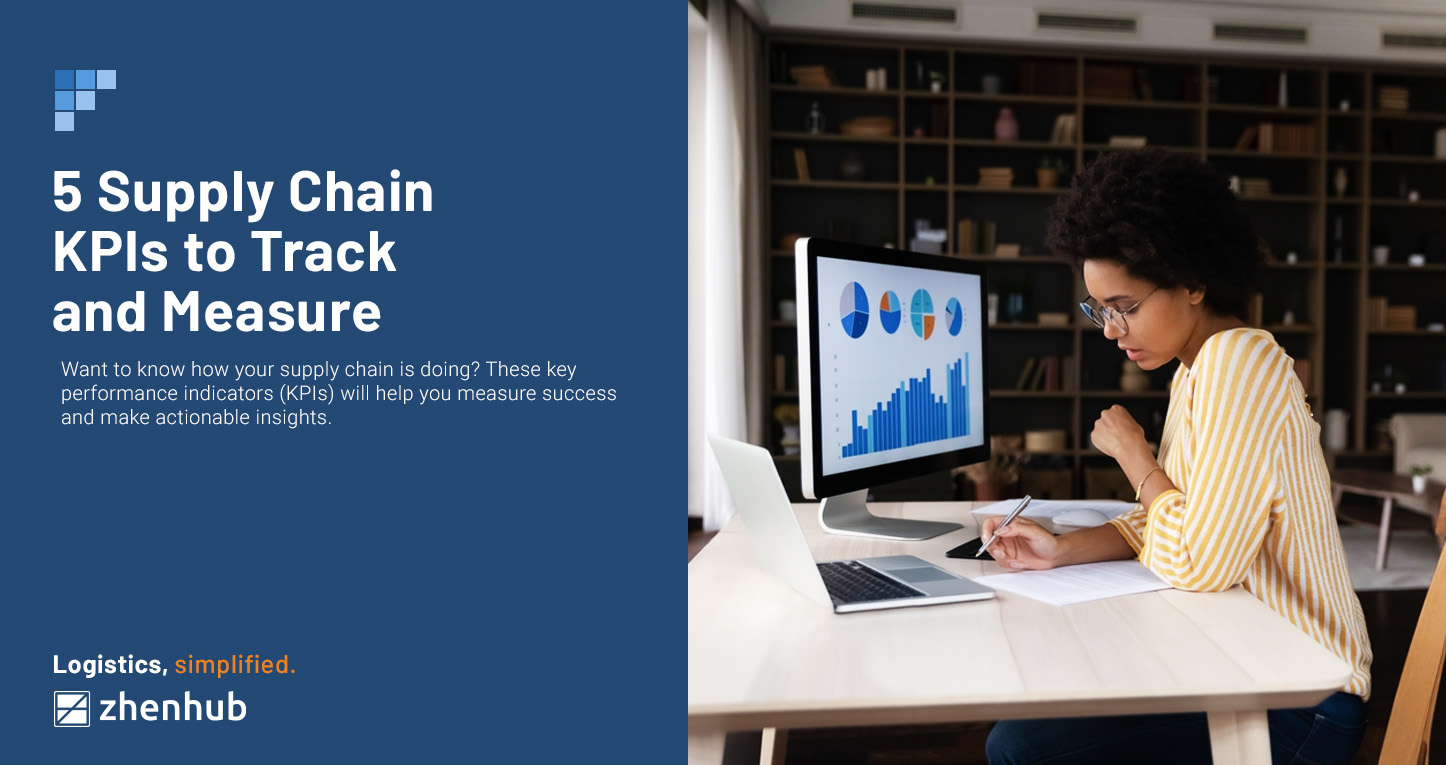
5 Supply Chain KPIs to Track and Measure
Time to read: 5 minutes
Running a smooth supply chain means tracking and understanding how your business performs properly. Understanding the right supply chain KPIs performance to focus on in your business is paramount to taking significant steps in the right direction.
The recipe for success includes reflecting on what you did, right or wrong, in any task and learning from it to be better & move forward. This approach applies to our daily lives and is especially important in business.
To achieve growth, you need to look back at performance as a basis for any future strategy or choices you’ll make. With 2022 bringing in numerous challenges for businesses, it’s imperative to understand how your business performs in different situations. Doing this can give you the answers in future planning sessions.
Tracking key performance indicators (KPIs) is a simple yet often overlooked part of logistics. Sometimes it isn’t easy to do this manually, but many digital solutions help track essential data. By measuring, monitoring, and reporting on the numbers that matter the most, you introduce a system of best practices to govern your business.
Every single factor counts, whether it’s a parcel shipped late or inventory that doesn’t translate into a sale. These all form the benchmarks for the foundation of your business. Customers demand excellent performance from online sellers. Buyers negatively react to supply chain issues, with 61% of them feeling frustrated.
Ignoring the signs of slowdown and issues can cause significant problems for your supply chain later. Be proactive in finding solutions through monitoring your supply chain KPIs.
What are Supply Chain KPIs, and Why are They Important?
KPI is a practical measurement of progress, easily quantified, reflecting business performance over a certain period. These metrics are compared toward a previously determined goal or a required performance standard. Supply chain logistics are often very unpredictable; one lagging area can have a domino effect on overall performance. Maintaining control and flexibility is possible by monitoring the right supply chain KPIs.
Supply chain metrics offer a wealth of information to better understand your company’s supply, inventory, and delivery networks. Collecting KPIs for each process will give you the data necessary to make crucial business decisions. These decisions, such as allocation of resources like labor or budgeting for transportation costs, are more meaningful when backed by purposeful data.
Supply chain KPIs offer a way to measure and evaluate the performance of your business. You can achieve this by accessing objective quantitative data and qualitative insight to devise effective strategies for achieving business objectives. It can also help improve staff availability in all operations, improving processes and efficiency.
5 Supply Chain KPIs to Consider Tracking
KPIs should help you run an effective and efficient organization. Specifically, when tracking KPIs, you should be looking at metrics that increase productivity and improve customer satisfaction. Each function should contribute to overall supply chain performance and focus on a critical element.
Remember that KPIs vary from company to company across different industries. The rule of thumb is to consider which performance elements can influence a specific target audience. Whether this is an internal or external audience, it’s best to keep the metrics measured to a few.
On Time-Delivery (ETAs)
((Total Number of Orders – Number of Error Orders) / Total Number of Orders) * 100
This metric determines the percentage of sales deliveries made on time. Knowing when your shipments will arrive can be tricky, especially if you have a lot of stops and destinations. It becomes complex with large amounts of shipments. And any hiccup could cause a chain reaction throughout other organizations’ supply chains.
On-time, in full (OITF) is a related statistic to measure. It is vital as it helps keep your items in stock when customers want to buy. As an online merchant, the challenge is keeping costs down while still meeting customer expectations for inventory control. It’s also essential to have enough goods available on time and within a specific time frame.
For maximum supply chain efficiency, consider this specific KPI.
Carrying Cost of Inventory
Inventory carrying rate * Average inventory value
The Carrying Cost of Inventory metric measures how much it costs to store inventory over time. This cost is usually associated with owning and maintaining a warehouse. It also includes paying salaries for employees and any losses due to theft or damage to inventory levels. It also takes into account rent on space where goods are stored. These factors can all add up quickly if not carefully considered.
Carrying costs amount to around 15% per year (on average), meaning that companies must sell at least this many units every 12 months. This way, they don’t start losing money before making a profit off their sales. Reducing these expenses will result in increased earnings because more sales mean higher revenue.
Gross Margin Return on Investment
GMROI = (Gross Profit) / [(Opening Stock – Closing Stock) / 2] * 100
Gross Margin Return on Investment (GMROI) is a key financial indicator that tells you exactly how profitable your company has been with its inventory investment. You can identify slow-moving items by monitoring Gross Margins monthly and use this information for improving planning, production output & warehousing operations. Maximize the return from every dollar spent by understanding which items should be prioritized for sale or what products will best benefit from new strategies.
Since companies invest a substantial amount of money into the goods and services they sell, the logical outcome is that they want their return to be bigger. GMROI helps business leaders pinpoint which of their offerings perform the best. This metric calculates how well the company performs when it comes to turning inventory into money above its costs.
Fill Rate
((Total Number of Items – Number of Shipped Items) / Total Number of Items) * 100
Fill rate measures how many packages or SKUs are successfully shipped on the first attempt. It can be used as an important supply chain KPI to monitor your company’s supply chain performance and potential issues with delays, quality violations, and other concerns.
Companies should closely monitor the fill rate to help maintain high customer satisfaction levels and have a healthy brand reputation. Important benchmarks that you can start are all related to delivery: completed orders, efficient lines that work on time, or individual items that are delivered properly on the first try. Spotting any discrepancies in your fill rate makes it easy to determine which fulfillment factor needs adjustments.
Customer Order Cycle Time
Actual Delivery Date – Purchase Order Creation Date
Customer order cycle time can be an essential measure of your supply chain’s responsiveness.. It measures the average time that lapses between the date a customer places an order and the delivery date.
Take special note of cash-to-cash turnaround which is the amount of time it takes from when orders come in until they’re shipped out. If this number of days has been increasing, but customer demand hasn’t changed, there might be a problem with your fulfillment process. Factors such as the actual delivery process and inventory management can get affected. Examining other vital metrics like invoicing times may provide insight into what can cause unexpectedly long wait periods between purchase orders being completely processed.
Leveraging Supply Chain KPIs for Growth
Supply chain KPIs can reveal the financial health of your business. They provide valuable insights into the operations and efficiency in different areas, which will help make smart decisions faster.
Logistics are complex systems that are challenging to manage but present great opportunities to innovate. Eighty-one percent (81%) of supply chain professionals believe analytics will be important in reducing landed costs. Gartner forecasts that 76% of commercial application vendors of supply chain management will deliver embedded advanced analytics (AA), artificial intelligence (AI), and data science by 2026.
Don’t focus on KPIs that will make your company look good on paper or appeal to stockholders. Being selective with your metrics can lead to inaccurate analytics and ill-advised decisions. Choose a consistent schedule to update your data. Whether it be daily, weekly, or monthly, having a clear timeline allows greater insight into the effects of internal and external factors.
The best supply chain managers prepare for challenges that come their way. Ensure smooth operations by paying close attention to inventory levels, tracking shipments, and monitoring customers’ needs throughout all parts of your process. From start to finish, you should be aware of everything.
The optimal balance between efficiency and effectiveness can only happen when there is good analysis at every stage. It should include knowing what metrics to use and making the data accurate to tell if the business is improving or worsening.
ZhenHub offers all-in-one logistics software solutions that help your business track fulfillment performance and shipping data in a convenient dashboard. Get real-time insights on inventory movement and manage multi-channel orders on the same platform. Take the first steps to use logistics analytics to your advantage. Sign up at our website now or request a free quote to kick things off.


